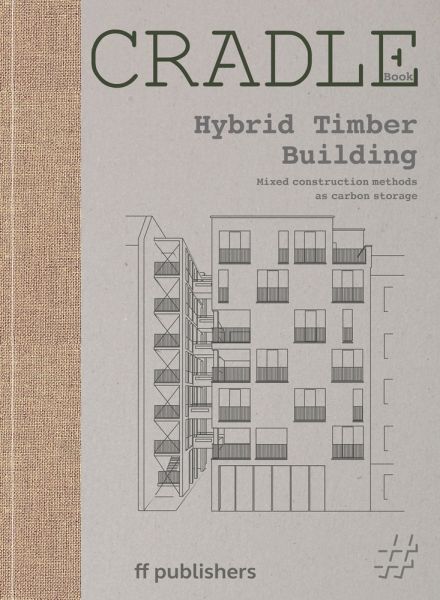CRADLE Book: Hybrid Timber
Mixed Construction for Carbon Storage
Hybrid timber construction is a sustainable and climate-friendly method of construction in which wood plays a major role, partly replacing concrete, stone, or steel. However, building regulations, fire protection, or other problems often present obstacles to pure timber construction, necessitating the use of hybrid timber.
The volume Hybrid Timber Building showcases 50 projects, from family homes to large office buildings, that address these challenges and were constructed using timber hybrid construction.
Preface
Why Hybrid Timber Construction? 6
From the CRADLE Magazine: Tom Kaden – More Wood for the City 8
Thivya Athmanathan und Roland Bechmann (Werner Sobek AG): Hybrid Timber from an Engineering Viewpoint 14
From the CRADLE Magazine: Gaus Architekten – Wood vs. Fire 18
Sarah Reißner (Züblin Timber): Hybrid Timber Implementation 22
Projects 28
- 50 projects
Why Hybrid Timber Construction?
Building with wood is not only a climate-friendly construction method in itself, but also a way of reducing the rising CO2 emissions in the atmosphere. Timber hybrid construction is the pragmatic cousin.
Wood can counteract man-made climate change. The amount of carbon dioxide (CO2) – or more precisely greenhouse gases in CO2 equivalents – in the atmosphere is more or less linearly related to the rise in temperatures. Since the beginning of the industrial revolution around 1850 to 1900, they have risen significantly. Unlike the regenerating ozone layer, for example, these CO2eq will change on their own. If humanity wants to limit the rize in temperature to 1.5° C since around industrialization – the original goal of the Paris Climate Agreement – it is possible to say quite precisely how much CO2 the atmosphere should contain: around 800 gigatons. At the beginning of 2023, the remaining budget for this target was 250 gigatons, which would also be used up in six years based on current emissions. Now, permanently exceeding the 1.5° or 2° C limit would not be the downfall of humanity or the planet, as the limit was defined in Paris in 2015 in order to mitigate the well-known negative consequences and not exceed any of the so-called tipping points at which the climate system becomes unpredictable or the change irreversible. One of these tipping points relates directly to the construction industry and clearly illustrates the dilemma facing many of the measures being taken to combat climate change.
Hybrid timber construction is an effective and sustainable method of building that offers a more environmentally-friendly alternative to traditional construction techniques. Wood is the primary material used in this construction method, which also partly replaces concrete, stone, and steel in building applications.
The use of wood is an effective method of removing CO₂ from the atmosphere, as trees bind the greenhouse gas. The use of wood in construction helps to prevent the release of greenhouse gases that were previously bound by the tree or wood, through natural death or combustion.
However, building regulations, fire protection, and other considerations often present challenges to pure timber construction, leading to the use of alternative construction methods. The volume Hybrid Timber Building presents 50 projects from German-speaking and European countries, including family homes and large office buildings. These structures were constructed using a hybrid method combining wood and concrete or steel , with the objective of overcoming the challenges inherent to this construction approach.
The 240-page volume presents a variety of regional and design approaches to hybrid construction. Furthermore essays on engineering and economic efficiency provide insight into the subject's fundamental aspects.
The new series of CRADLE books is published in collaboration with CRADLE magazine. The monothematic volumes showcase exemplary projects with comprehensive text, facts, detailed and overview plans, and images. These aim to illustrate the technical diversity and creative integration of the respective approaches.
Versandkostenfreie Lieferung! (eBook-Download)
Als Sofort-Download verfügbar
- Artikel-Nr.: SW9783945539552458270
- Artikelnummer SW9783945539552458270
-
Autor
Chris van Uffelen
- Verlag ff publishers GmbH
- Seitenzahl 242
- Veröffentlichung 19.05.2025
- ISBN 9783945539552
- Barrierefreiheit Aktuell liegen noch keine Informationen vor
- Verlag ff publishers GmbH

